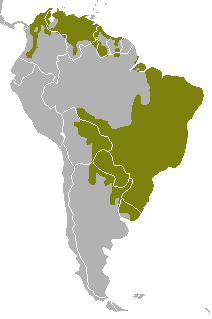Cerdocyon
| Crab-eating fox | |
|---|---|
 |
|
| Cerdocyon thous from Colombia | |
| Scientific classification | |
| Kingdom: | Animalia |
| Phylum: | Chordata |
| Class: | Mammalia |
| Order: | Carnivora |
| Family: | Canidae |
| Subfamily: | Caninae |
| Genus: |
Cerdocyon C. E. H. Smith, 1839 |
| Species: | C. thous |
| Binomial name | |
|
Cerdocyon thous Linnaeus, 1766 |
|
 |
|
| Crab-eating fox range | |
The crab-eating fox (Cerdocyon thous), also known as the forest fox, wood fox, or Maikong, is an extant species of medium-sized canid endemic to the central part of South America, and which appeared during the Pliocene epoch. Like South American foxes, which are in the genus Lycalopex, it is not closely related to true foxes: Cerdocyon comes from the Greek words kerdo (meaning fox) and cyon (dog) referring to the dog-and fox-like characteristics of this animal.
Cerdocyonina is a tribe which appeared around 6.0 million years ago (Mya) in North America as Cerdocyon avius becoming extinct by around 1.4–1.3 Mya. living about 4.7 million years. This genus has persisted in South America from an undetermined time, possibly around 3.1 Mya, and continues to the present in the same or a similar form to the crab-eating fox.
As one of the species of the tribe Canini, it is related to the Canis genus. The crab-eating fox's nearest living relative, as theorized at present, is the short-eared dog. This relationship, however, has yet to be supported by mitochondrial investigations. Two subgenera (Atelocynus and Speothos) were long ago included in Cerdocyon.
The crab-eating fox is a canid that ranges in savannas; woodlands; subtropical forests; prickly, shrubby thickets; and tropical savannas such as the caatinga, plains, and campo, from Colombia and southern Venezuela in the north to Paraguay, Uruguay and northern Argentina at the southernmost reaches of its range. (Eisenberg, 1999) The crab-eating fox has also been sighted in Panama since the 1990s.
...
Wikipedia

